What Awaits the SEO World in 2019?
We have entered 2019 and as expected the SEO world is changing in 2019. We may have a lot of questions about what trends are waiting for us, which terms gain importance and what we need to do for our websites in 2019. Therefore, to answer your questions, I would like to share with you The 2019 SEO Trends!
RankBrain
Google's description According to, RankBrain is one of the most important ranking factors.
So what is RankBrain and why is it so important?
Before RankBrain developed, the positions of pages ranked on Google were thought to be determined by engineers working on Google, but RankBrain's algorithm optimizes the position of the pages, taking into account users' clickthrough rate, bounce rate, page retention time, and pogo-sticking rate.
To put it as an example: When doing a query of "new york" at SERP:

Users usually enter the first page but if the content on the page is not illustrative, does not appeal to the user, and if the user can’t find the subject she is looking for in a compelling way, she will leave immediately and enter the second page:
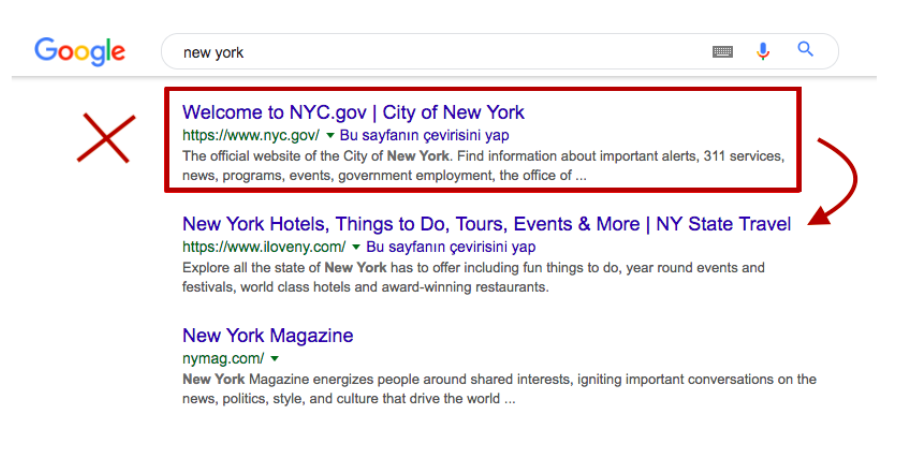
If she doesn't like the content found on the second page, she clicks on the third page:
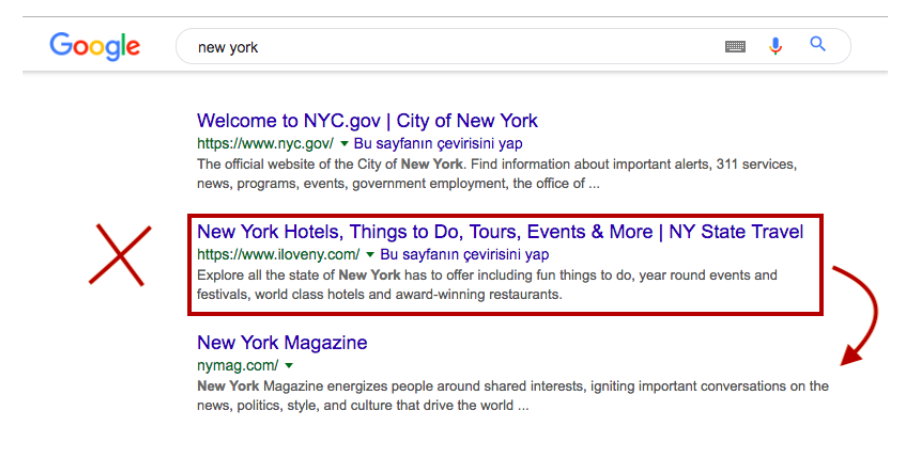
Finally, she likes the page in third place and starts reading the content. This situation of entering pages, leaving them quickly and then returning to the query page is called Pogo Sticking and it is identified as a very important factor for RankBrain. RankBrain detects a ranking page on Google that has a high bounce rate and is constantly pogo sticking, and the first ranking page in the example above falls to the 2nd or 3rd place, and the one that was originally on rank 3 with content that the users like can rise to top rank, thus the pages that are measured well by factors which are important for the user experience are placed in the top positions.
RankBrain cares about:
- Dwell Time,
- CTR,
- Pogo-Sticking,
- Bounce Rate.
Dwell Time
According to Google's description Dwell Time is very important for RankBrain. You can read the related article here. According to the survey from Searchmetrics, the average Dwell Time of the top 10 pages listed on Google is 3 minutes and 10 seconds.
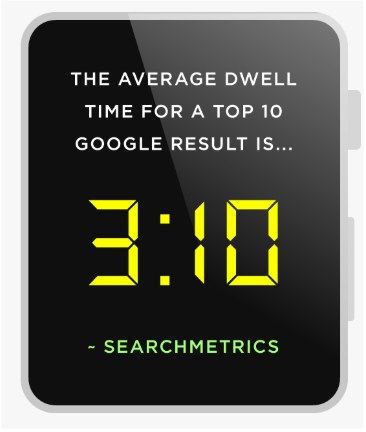
You should try to keep users stay on the website longer than this average!
So how do we do it?
- Using Bucket Brigade:
Bucket Brigade is the practice of using phrases in the content that will draw the attention of the readers. You should use interesting phrases to ensure that readers won't get bored and thus stay longer on the page.
For example:
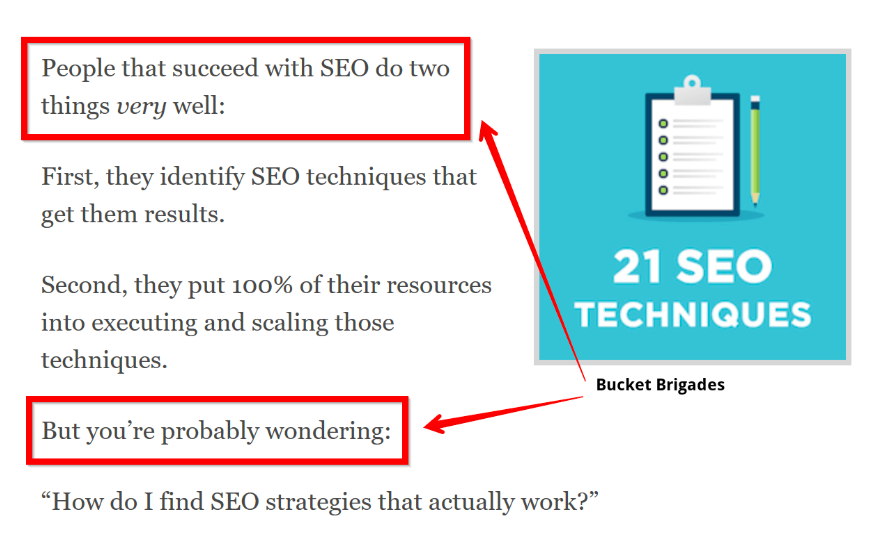
- Using Benefit-Driven Subheadings:
You should divide long articles by subheadings so that the reader won’t get bored from the wall of text. As shown below, the content on the left side is separated by subheadings, while the content on the right side does not have subheadings. This will adversely affect the user experience, causing the user to leave the page immediately. Therefore, subheadings such as the structure on the left side should be used:

- You should use the APP Formula:
Agree: In the first paragraph, the things that support the thought are written, Promise: A certain situation about the subject written is indicated, Preview: The general prediction about the subject written is mentioned in the last paragraph. When a text is written in this way, the user is provided with an environment for easier reading and understanding, and this situation has a positive effect on bounce rate and pogo stick rate. Brian Dean's video on this topic can be found here.
User Clickthrough Rate (CTR)
Since ad pages and featured snippet pages appear over organic pages, users' clickthrough rate on an organic page is gradually decreasing. For this reason, users click on the pages that come out first in their search and are more descriptive. As a result of a study, the organic click rate on mobile devices was announced to decrease by 41.4% as of 2015. Therefore, a page that attracts attention should be created to make the users click on the site. You can have users click the page with a striking title and a descriptive meta description! The higher the clickthrough rate of a webpage, the higher the chance of the site being viewed. Optimizing meta tags is important to gain high clickthrough rates on web tags. Larry Kim's infographic on how to increase the clickthrough rate be found here. In addition, you can find Brian Dean's video of “Click Magnet Method” on how to increase the clickthrough rate from here.
Featured Snippet
As we mentioned in CTR, Featured Snippet is an important factor. According to research conducted by SEMrush, Featured Snippet exists in 11.3% of all search results.
So how do we get our page to Featured Snippet?
We need to identify the keywords we rank in and focus on the words that we want to be successful in Featured Snippet. 98% of the content in Featured Snippet consists of content that ranks on the first page of Google. Therefore, if our page is not in the top 10, the possibility of appearing in Featured Snippet gets very low. In Ahrefs' research, the rate pages appear in Featured Snippet according to their ranking positions is as follows:
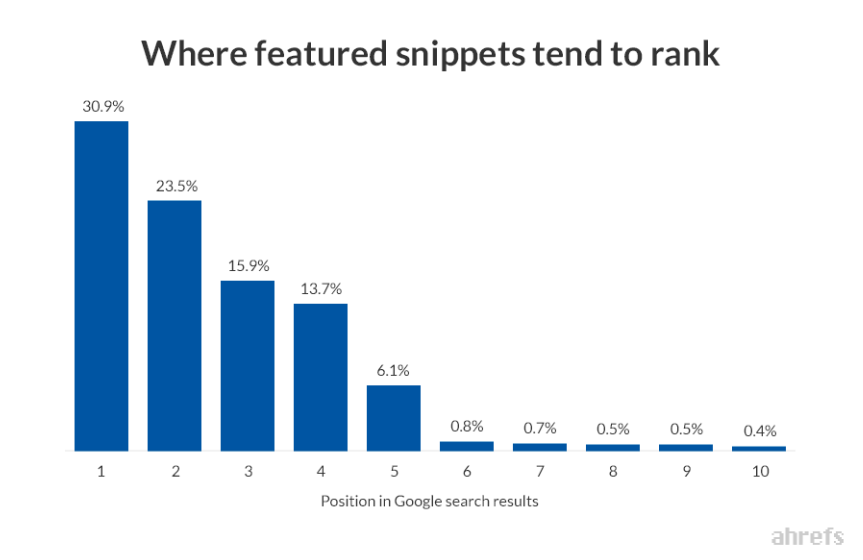
Which keywords do we need to choose?
Ahrefs shows the words that our site is ranked in Featured Snippet, from here you can create a strategy by identifying the words that your site and your competitors are ranked in:
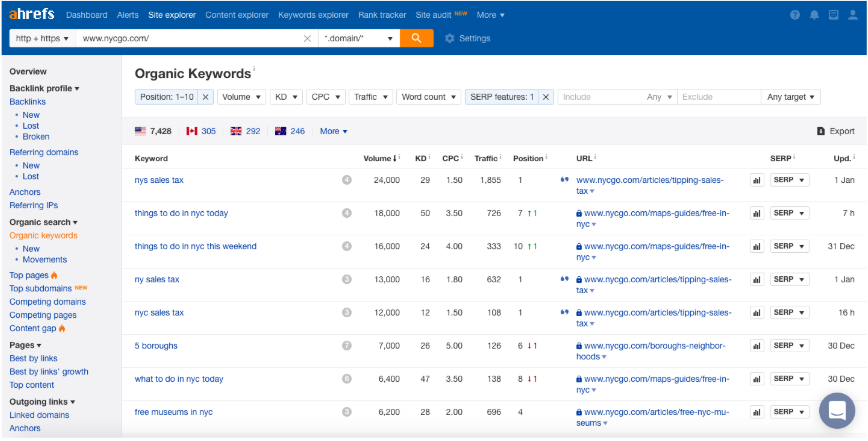
After identifying the words we are listed in Featured Snippet, we prepare content with 40 - 60 words with the words listed in the top 10 positions. 40 - 60 words were according to the result of a research SEMrush done on the contents that appear on Featured Snippet. Finally, we have to choose which Featured Snippet type we target.
Featured Snippet Types
There are three types of snippets:
Paragraph, list and table.

The most commonly used snippets are paragraphs.
Paragraph Snippet example is as follows:
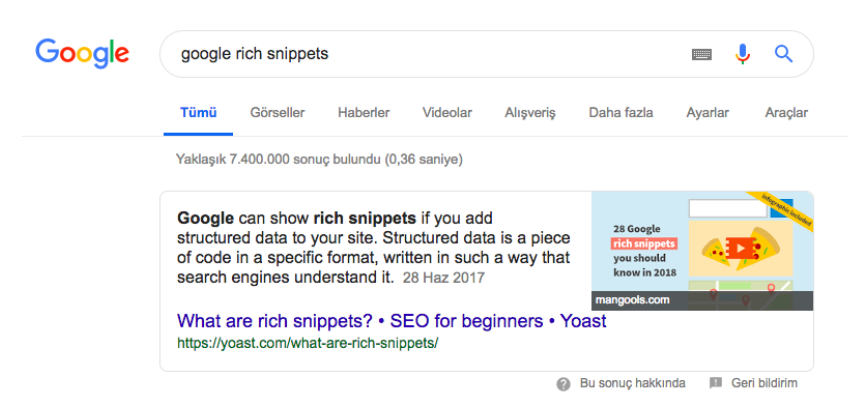
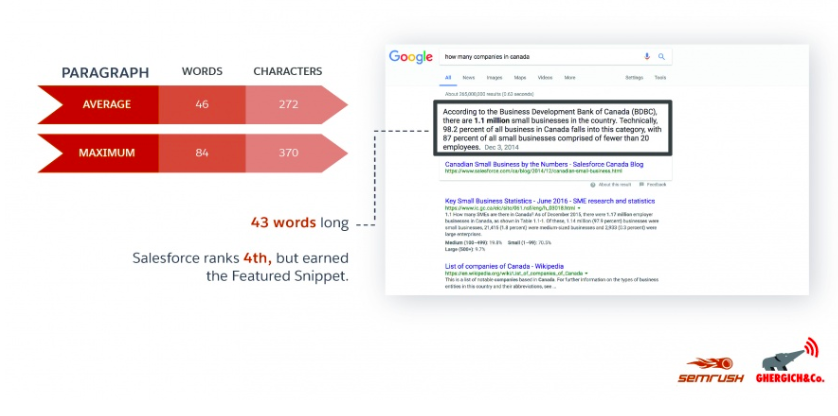
List Snippet example is as follows:
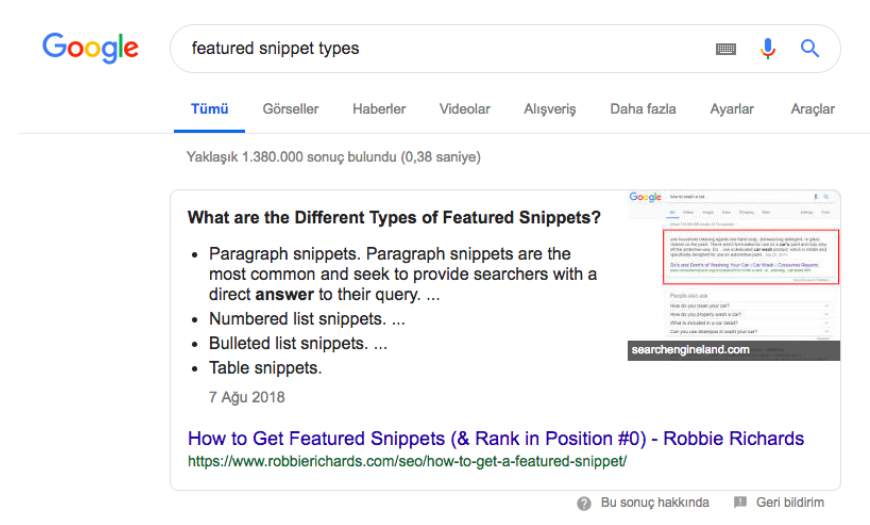
You should create lists that are as long as possible to appear in the List Snippet, because when you create a long list, Google will have to interrupt the results, which causes the user to click into your site. If you use a shortlist, try to use enough words for each item, so Google shortens each list item and the user becomes curious about your post. You should set the number of items in your lists to be 5 at least and 8 items at most:
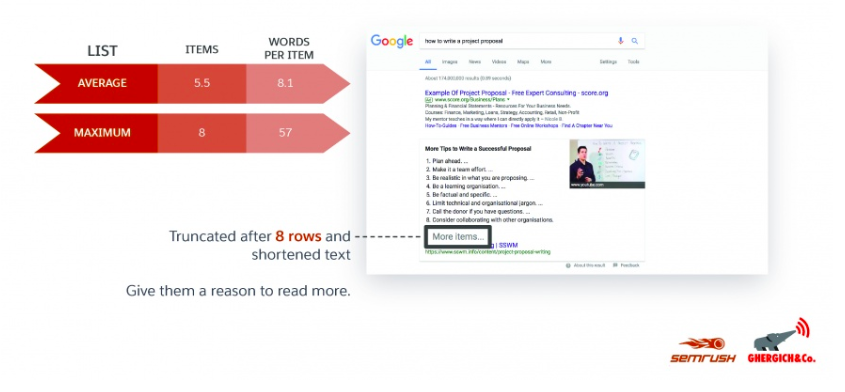
Table Snippet example is as follows:
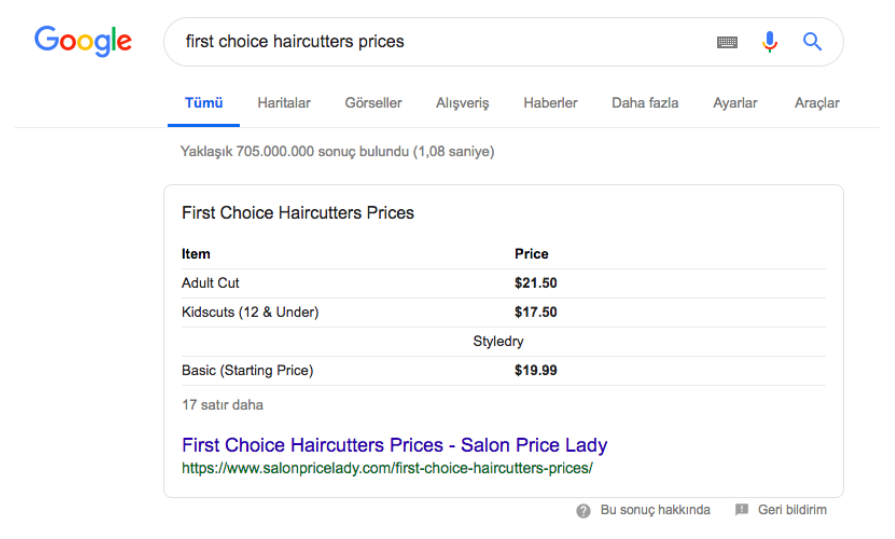
Just as in list snippets, you should create tables that Google can truncate. You should focus on keywords that will create a purchasing cycle.
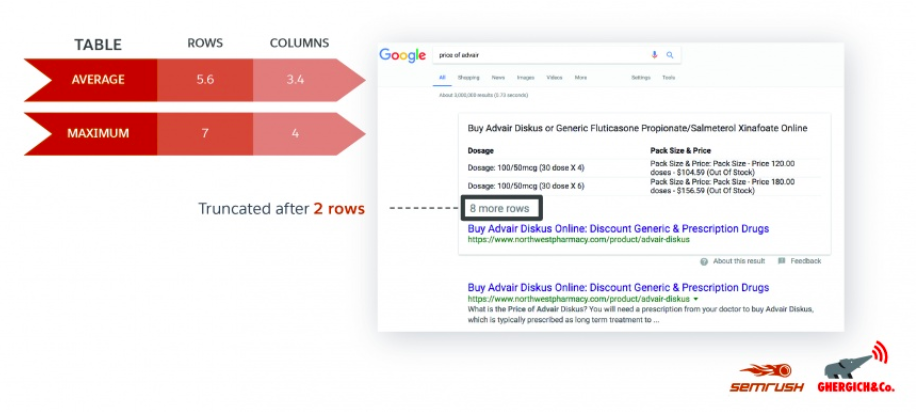
We recommend that you update the words and expressions of the content for Snippet types. This will be very important in 2019!
Comprehensive and Extensive Content
In 2019, the importance of content is expected to continue. Google's working logic used to be content-only, so it crawled the HTML code of the page to look at the use of words. Therefore, Google visits your page to see if keywords appear on it and check the following metrics for this:
- Title Tag
- URL
- Visual Alt text
- Description Tag
- H1 Tag Although
Although Google still checks the same metrics, we should say it's gotten smarter. It now focuses on the quality of the content instead of directly measuring the content. Google emphasizes content that covers the whole topic in-depth extensively, rather than keyword-intensive content. If your content encompasses a wide range of queries the user is looking for comprehensively, the user will end the search there and stay on your page as long as necessary to consume your content. This will reduce the likelihood of inclination to go for different content.
How can we write a comprehensive content?
First, let's note the number of words. Our content should be long, comprehensive and user-friendly. But we need to be careful not to include unnecessary text in order to be long, because in 2019 our ultimate goal is to produce useful content that fully meets the user's search query. And as always, let's not forget to analyze the length of competitor content!
Second, let's pay attention to publish evergreen content. Buzzsumo has created a report by reviewing 100 million content. I have listed the most important points for you below:
- An average blog post was shared in 8 places on social media in 2015, and 4 places in 2017.
- While Facebook traffic starts to decline towards 2018, Google continues to rise:
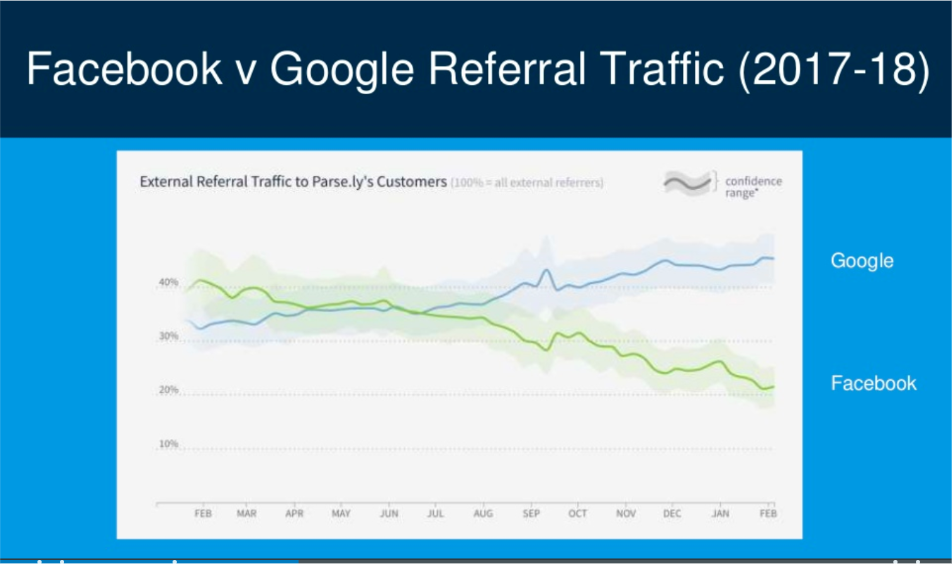
- The distribution of content sharing on social media is as follows:
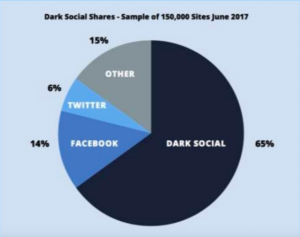
- The sharing ratio of content according to the number of words they have is as follows. As can be seen, the number of words and the sharing rate are directly proportional:
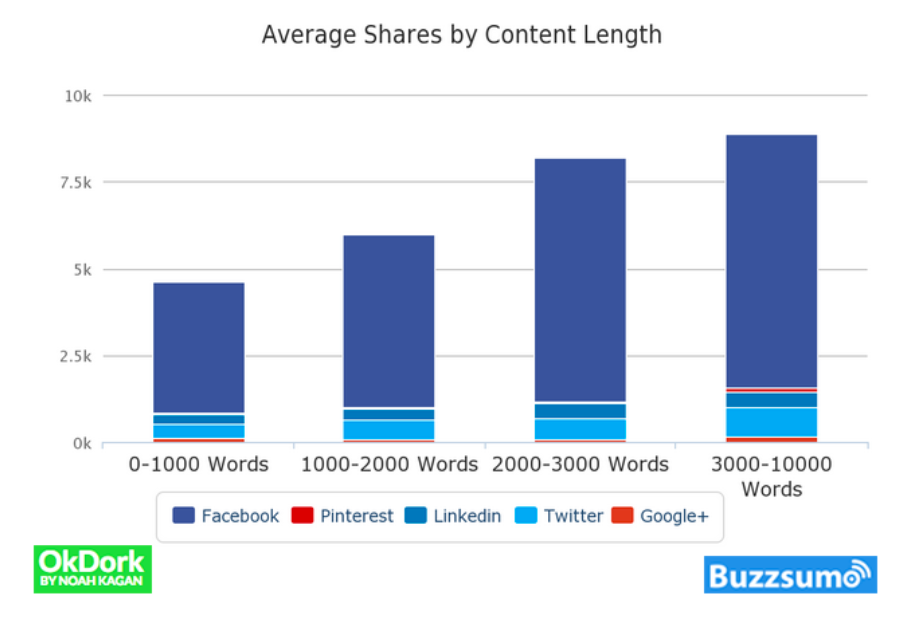
- 70% of the content does not have backlinks.
- Pageviews through WordPress have recently gained a downward trend tendency:
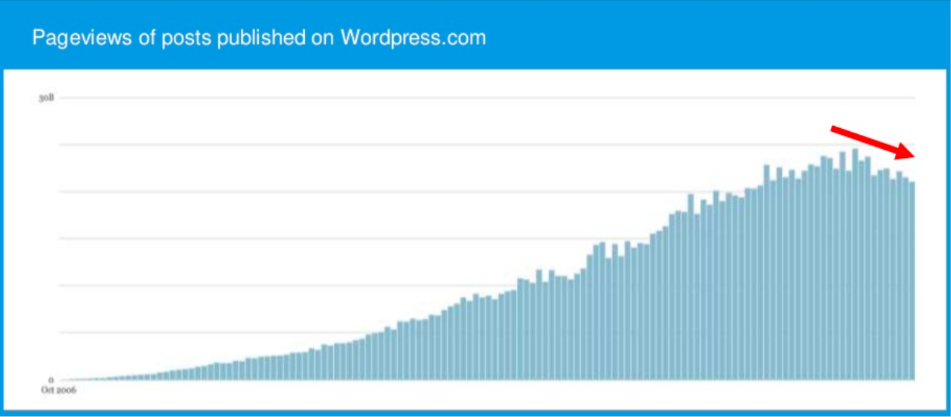
As a result of this research, it can be seen that only evergreen content gets backlinks and has its shares continue to increase. Therefore, in 2019, we should make sure that our content is long but comprehensive, meaningful to the consumer, extensive and evergreen.
Third, we need to add LSI keywords to our content.
What is LSI?
When Google Bot crawls pages, it looks at the words inside the page and the semantic integrity of the text and whether there are words that can be associated with the users’ search on the page. This crawl process creates a semantic link between words by looking at which words are used together and which words are not used together. Since the purpose of search engines is to reveal useful articles that appeal to the user, semantically linked articles take a step forward. Latent Semantic Indexing is one of the methods used to help the user reach the result. For example, let's say we will publish a blog post about Valentine's Day. We must provide integrity by using words like what is Valentine's Day, Valentine's Day gifts, February 14, romantic dinner, wine, valentine's gift, in our blog post. When Google crawls our page, it notices that there is a link here with the LSI method and that our blog post is comprehensive, so it positively affects page ranking.
So how do we conduct LSI keyword research?
We can reach LSI keywords by doing a Google search.
To expand from our example; When Valentine's Day search is done in SERP, you can enrich your content by using and diversifying the words that Google suggests.
When you search with the Google extension “Extract People also search phrases in Google “, you can see which other words users who clicked that page also search for. Thus, you can enrich your blog post with related words.
You can review different contents. The words you will see by reviewing the content on the first page when you search can give you an idea.
You can acquire a variety of words using the tool Google Keyword Planner.
Mobile-First Indexing Optimization
Today, approximately 60% of Google searches are made via mobile and in niche searches, this rises even to 90%. Therefore, it is important to ensure that the website has a responsive design, or that equivalent content has been produced on both mobile and desktop versions. Google has now announced that it will designate the mobile version as the priority ranking factor. If you have a mobile version of your website, Google will determine your ranking by scanning it first.
How is mobile optimization done?
The desktop and mobile version must be identical.
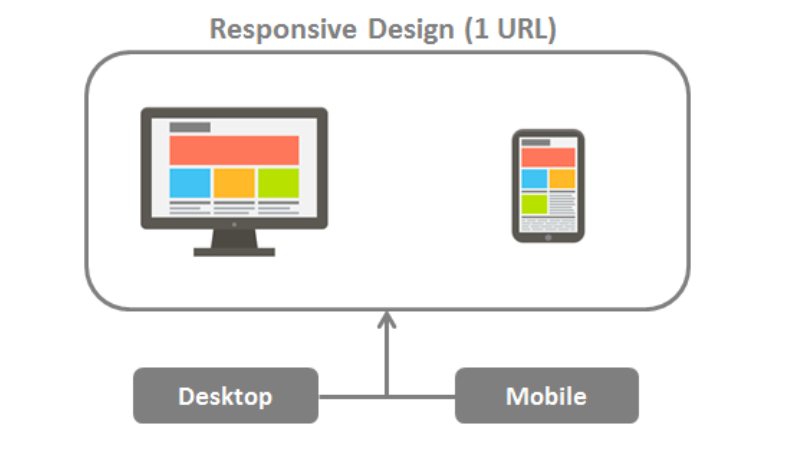
As we know, since the desktop screen is wider than the mobile screen, the difference in page structure can create a problem. Not everything that exists on the desktop may appear directly in the mobile version. We will solve the problem with “hamburger menu” and “accordion menu.”
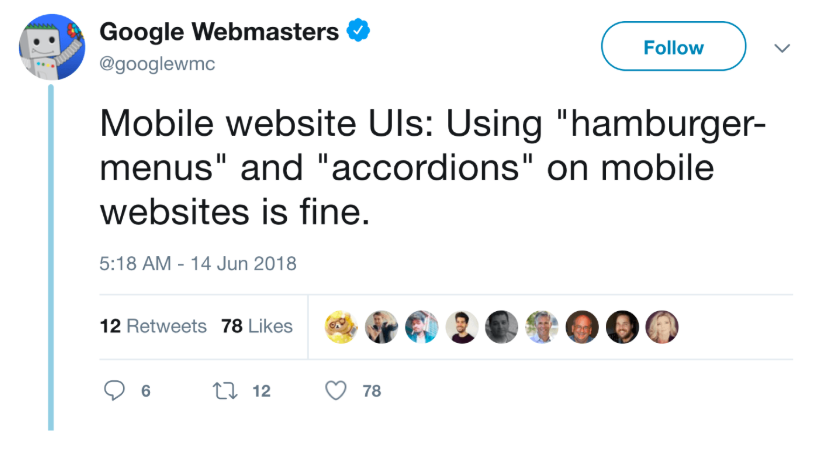
You can find more information on this topic here. You can also reach the Mobile SEO Guide article on our blog here. Let us showcase zeo.org as an example of Responsive Design. Let's examine how the whole page looks in mobile version:
As you can see, our site has a responsive structure. All links, categories and content on the homepage are available in our mobile version in an ordered and regular fashion. The hamburger menu in the upper right corner contains the categories in our desktop version:

You need to make sure your site is mobile compatible!
We always emphasize how important the user experience is. This is where its full importance is revealed. With the increase in mobile searches recently, the user experience in mobile is even more important. Therefore, when users enter your mobile site, they want to have the same speed and the same quality experience, but if your site is not mobile compatible, the user will want to exit immediately since they will see a slow and irregular site, and this will affect RankBrain mentioned in the first section. That's why we need to do the mobile compatibility test meticulously!
So how do we test the mobile compatibility of our site?
Have you met the Google Mobile Compatibility Test tool for this? Yes, it is a tool that most of us know, but it is very effective. Let's analyze zeo.org here step by step:
As you can see, our site is marked as mobile compatible, but there may be loading problems on the page. If there are issues, you can find out what these issues are by taking the following steps:
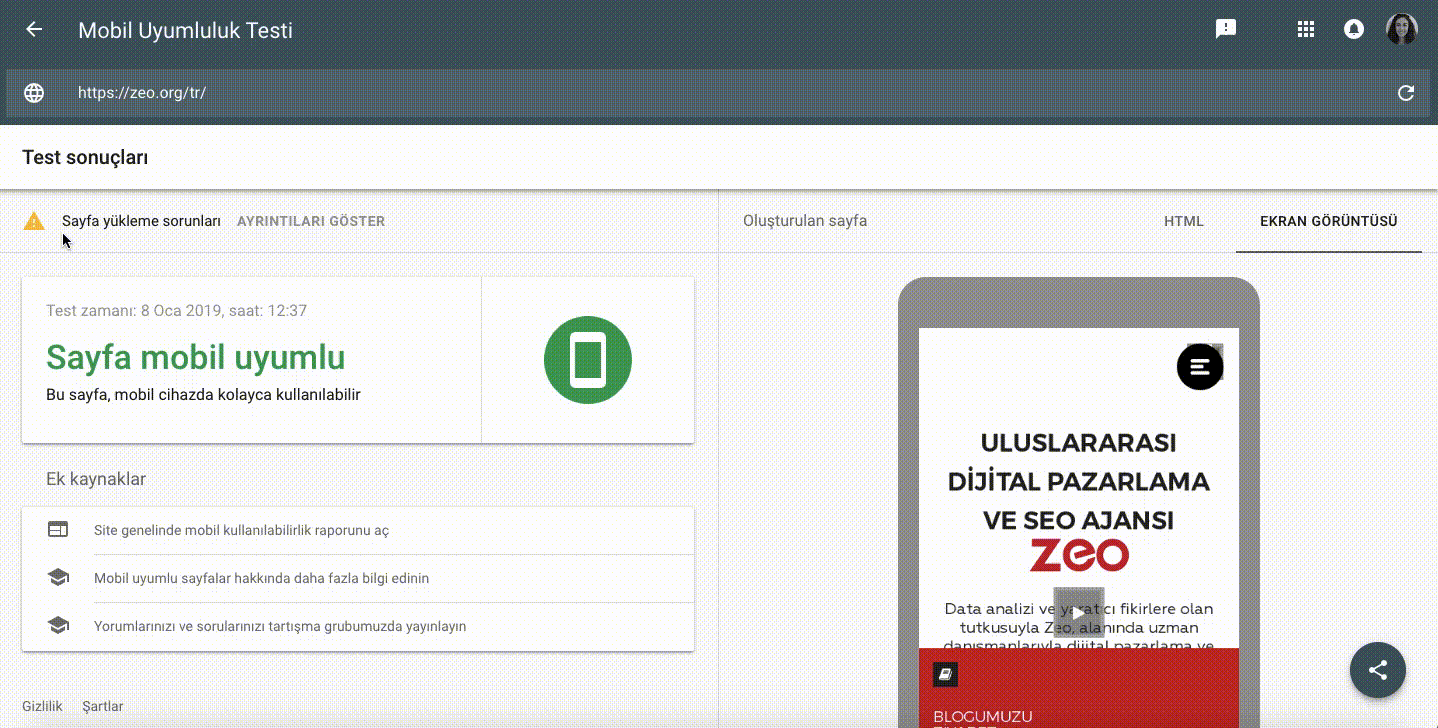
After examining page load issues in the section I've shown above, we can see where our issues originate from in the Search Console Mobile Usability section. We'll find information on how to resolve non-mobile pages and issues on our site:
Once we've identified and resolved our issues, the only factor we need to check is to make our page mobile compatible; Mobile Site Speed. We can measure the speed of our mobile pages with Google’s Page Speed Insight tool. We load the URL of the site into our tool and get the result of the analysis:
After waiting for the analysis to complete, we find out the speed of our site and the pages with issues. We can also find solutions to the problems and improve the mobile site speed score here too.
Video Content
A report created by Animoto in 2017 mentions that video content will account for %80 of organic traffic by 2020. In the blog post of HubSpot, it is mentioned that 43% of users want to see more video content:
As a result of this research, the importance of video content increases. That's why we need to optimize our pages by creating blog video content.
So how should we create video content?
According to research conducted by Rand Fishkin, the second search engine used after Google was YouTube. Related articles can be found here. Related articles can be found here.
According to research, most users utilize the Youtube search engine to search, and maybe, who knows, YouTube will even surpass Google in the future. For this reason, you need to optimize YouTube content in 2019! The presentation on “YouTube Video Optimization” actualized at ZEO Agency's Meetups can be found here. According to one survey, users encounter video content in their queries 55% of the time, and 10% of this ratio belongs to YouTube videos. As you can see below, the results of the queries are images 40 % of the time, news % 13 of the time, and videos 55 % of the time as we mentioned.
For example:
And in addition, videos are now featured in Featured Snippet on Google! As a new snippet “Video Featured Snippet”:
This shows us that when we prepare our videos, we also need to focus on all the metrics we pay attention to in Featured Snippet! Finally, we have seen that users prefer video content and video search results based on all the research, thus what we need to do is integrate video into our blog posts. Presenting the content to the user as a video instead of a long article will increase the user experience and thus, we will decrease our the bounce rate. While there are already many reasons to create a powerful video on YouTube, this situation adds yet another reason. Some tips on what to do to appear on Video Featured Snippets:
- It's important for your site to rank on the first page. The ranking factor, which is an important issue for all Snippets, is important here too!
- The description used for the video should clearly state our targeted question!
Voice Search Optimization
As a result of a survey held in 2014, Google stated that more than 40% of users used voice search, and among young people, this ratio was even higher than 50%. According to Google, one in every five search queries on mobile devices are now performed by voice search. Due to the increasing use of digital assistants and smart home devices, users will likely use “Voice Search” even more often in 2019. The article about this subject can be found here. The presentation from Hande Parmaksız of our team about Voice Search can be found here. According to the research Google held in 2014, the following values emerge:
We must optimize our content by taking the research into account!
So how do we optimize the content?
First, we need to understand how users search with Voice Search. I've created a list for you by perusing the research held:
- In a voice search, queries may be longer.
- Search queries are likely to have question patterns.
- Users are looking for quick and direct answers.
- Queries are more likely to be local.
In the voice search, queries may be longer: Making a search by speaking makes it faster than typing, so when making a voice search, a longer and more accurate search is done compared to text search. Although text searches are on average two words long, voice searches will probably exceed 2 words. For this reason, we should include long keywords that we call long-tail keywords. By using long tail keywords, we will be precisely targeting the keywords queried by users. For example, according to the research above, our young audience does the searches most often while watching television. As an example of a search conducted while watching television, the user can look at an actress she sees on the screen while watching a movie and searches by saying, “... in which movies did she play?” which is, as can be seen, a long sentence. Of course, this was only an example given in the context of television. Voice search is an action taken to avoid having to deal with the phone while doing something else. The related article can be found here.
The search queries are likely to have question patterns: As I mentioned in the item above, since the query will be done by speaking normally in a voice search, it will be made as if a sentence is formed. For this reason, while text search is generally done using keywords direct; during voice search question molds such as “what”, ”who”, “where” and so on can be utilized. For example, we want to have our shoes repaired. We will probably write “cobbler” when we search by typing; during voice search, we can search for “Where is the nearest cobbler?” In the two queries we gave as an example the same thing is being searched for, but as long sentences and question patterns are used in voice search, care should be taken to prepare descriptive texts for these types of queries. A page that should be prepared for such queries is the “FAQ Pages”. When frequently asked questions are added to a website, we can target keywords in queries that occur in voice calls.
Users are looking for quick and direct answers: Zero-ranking “featured snippets” emerge here too. In Voice Search, the content in Featured Snippet is read aloud to the user. Thus, the user does not have to look at the content while getting fast results. Isn't that what the voice search was all about? Didn't most people make voice searches when they were doing another task? This is exactly what the user wants! What we have to do here is to pay attention to Featured Snippets. We need to optimize the content on our website to make it to the rank zero. I have explained how to optimize the content in the Featured Snippet section. When we look for a location or business in SERP, we see a field like shown below:
This field is called Google My Business. The more accurate you make your Google My Business profile, the easier it gets to be involved in Local Pack Snippets. As can be seen above, when I search for ZEO Agency, I can see the address, phone number and working hours without clicking any page, which may be enough for me when I want to learn the business’ information. Since the users want direct results in voice calls this field is also very important for us.
Queries are more likely to be local: While speaking of Local Pack Snippet, let's talk about how in mobile voice searches, queries are local. Usually, “near” and “close” and “where” patterns are used when making voice searches. This situation signals us that users are very close to buying, so by improving your local SEO strategy, you can attract these users who are close to buying to your site. Sources related to Local SEO can be found here.
Link building still in progress!
We can say that the number of links is directly proportional to the tendency to rank first on Google. Getting a lot of links from the correct sites will help the site get to the first page on Google. If the site does not rank on the first page, Featured Snippet, Voice Search and RankBrain optimizations may not work. The following table has emerged according to the 1 million search results research of Backlinko:
Research shows that link building will continue and rise in 2019, so we should pay attention to quality content and linking references from other sites to our site!
How should we optimize our page to be referenced accurately?
- Content should answer to general searches.
- Relevant and relevant results should be brought to the user as a result of the searches.
- Recurring customers should be provided with immediate access to the products they purchased.
- The satisfaction of users should be provided so that the authority of our website increases.
- Chatbots should be utilized to reduce the density of frequently asked questions and customer complaints.
- Users should be able to easily reach the location of your brand or business.
- Ease for the user experience must be provided by using visual forms on the site
Attention to EAT Update!
Google released a new update on August 1, 2018. This was also confirmed by their official sources:
Sites started to decline after the algorithm was launched. Although most of the sites that declined were in the health sector, e-commerce sites have also been observed to drop. According to research held by Seroundtable, 41.5% of the sites affected by the update were health sites. In addition, 16% of the affected were e-commerce sites:
Google is giving importance to E-A-T updates, especially in sectors such as health and finance. Because such sites have a huge impact on people, they are called YMYL (Your Money Your Life) sites by Google. Most health and finance sites are thought to have fluctuated for this reason after the updates. Failure to create appropriate content for the update on affected sites explains fluctuations:
For this reason, the Quality Assessment Guidelines described by Google to create appropriate content must be reviewed!
With the EAT update, Google is looking for authenticity and expert knowledge in the posts! Therefore, content optimization should be done as a solution.
So, what should we consider when optimizing content?
- The content prepared for the health and finance sites should be written by experts and bibliographical sources must be given.
- Original publishing and update dates should be added to the contents separately.
- Content should constantly be updated and whenever there are fresh news or a new situation arises, they must be added.
- The bibliography should be included in the content containing research.
- As we have always emphasized, content should always be focused on the user experience. Visuals and videos should be used in the content for this reason.
- In addition, the contents, tables and citations should be added to the sites to facilitate the user experience.
Visual Focused Content Should Create
According to a report prepared in 2018, visual content is 32% important for marketers. According to marketers who attended the research, the change graphs of the contents for 2019 are as follows. Visual content comes after the video content. In 2019, more visual content needs to be created, especially embed images
So what are the benefits of creating visually-oriented content?
It will attract users to our content:
Users are more interested in visuals than boring text. Content with visuals delivers 94% more views than content without visuals.
With visual content:
- Express your brand,
- Convey a feeling,
- Highlight important data,
- Create Diversity,
- Showcase your products and offers,
- Increase traffic to your site.
Reading ration of content will increase:
Content with visuals has a greater chance of being read, liked, commented and shared compared to text-only content. If we look at the research results;
- Visual content is 40 times more likely to be shared on social media compared to other content types.
- Facebook content with visuals have 2.3 times more interaction rates compared to ones without visuals.
- Colored content 80% more reading interest on users.
- Tweets with embedded images receive 18% more clicks, 150% more retweets and 89% more likes.
Visual contents are easier to understand:
it is easier for our brains to grasp the visual rather than a long article. 90% of the information sent to the brain is visual and images are processed 600,000 times faster than text.
Visual contents stay in mind:
Visual contents remain in mind because they are easily understandable. Our brain quickly connects with the information stored in our memories. If you add an emotional and aesthetic appeal to your design, your brain deepens the coding and storage of that information. Images that delight or awaken emotions make your social media content more memorable for users. So when it's time to buy, viewers will remember your content. People remember 80% of what they see, only 20% of what they read, and only 10% of what they hear. Use images strategically. Thus you will help your readers remember you and your message.
There Must Be A Comment Area on the Web Site!
The presence of a comment area on the site is the easiest part to measure user feedback.
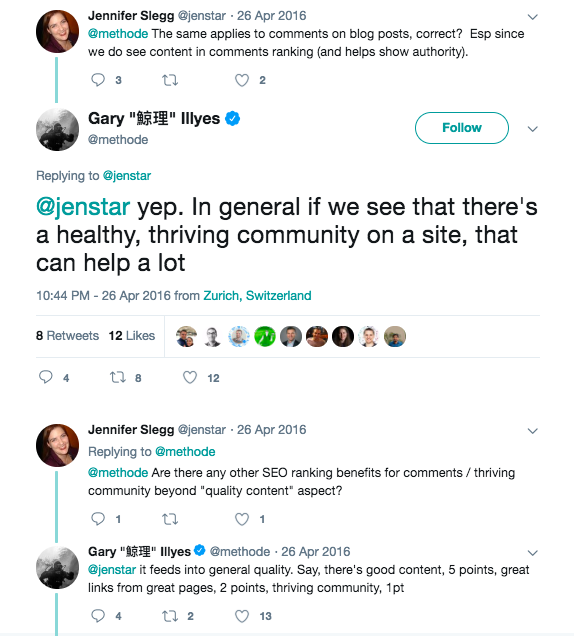
According to Google's disclosure content comments an ensure increase in traffic.
Google wishes to see an active community in your site and will pay more attention to this ranking signal in 2019! In the world of SEO, everything seems to be having more quality and more transparent in 2019. I hope it has been an enlightening source for you too!
Resources:
https://backlinko.com/seo-this-year
https://www.searchenginejournal.com/seo-trends/281053/
https://searchengineland.com/5-seo-trends-that-will-matter-most-in-2019-307641















